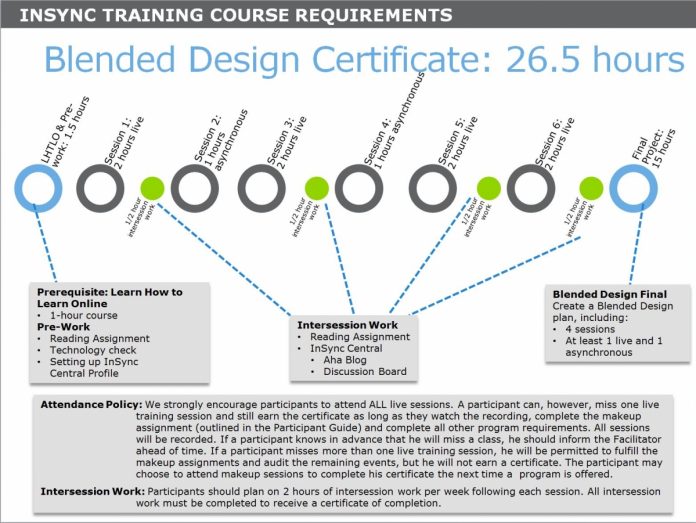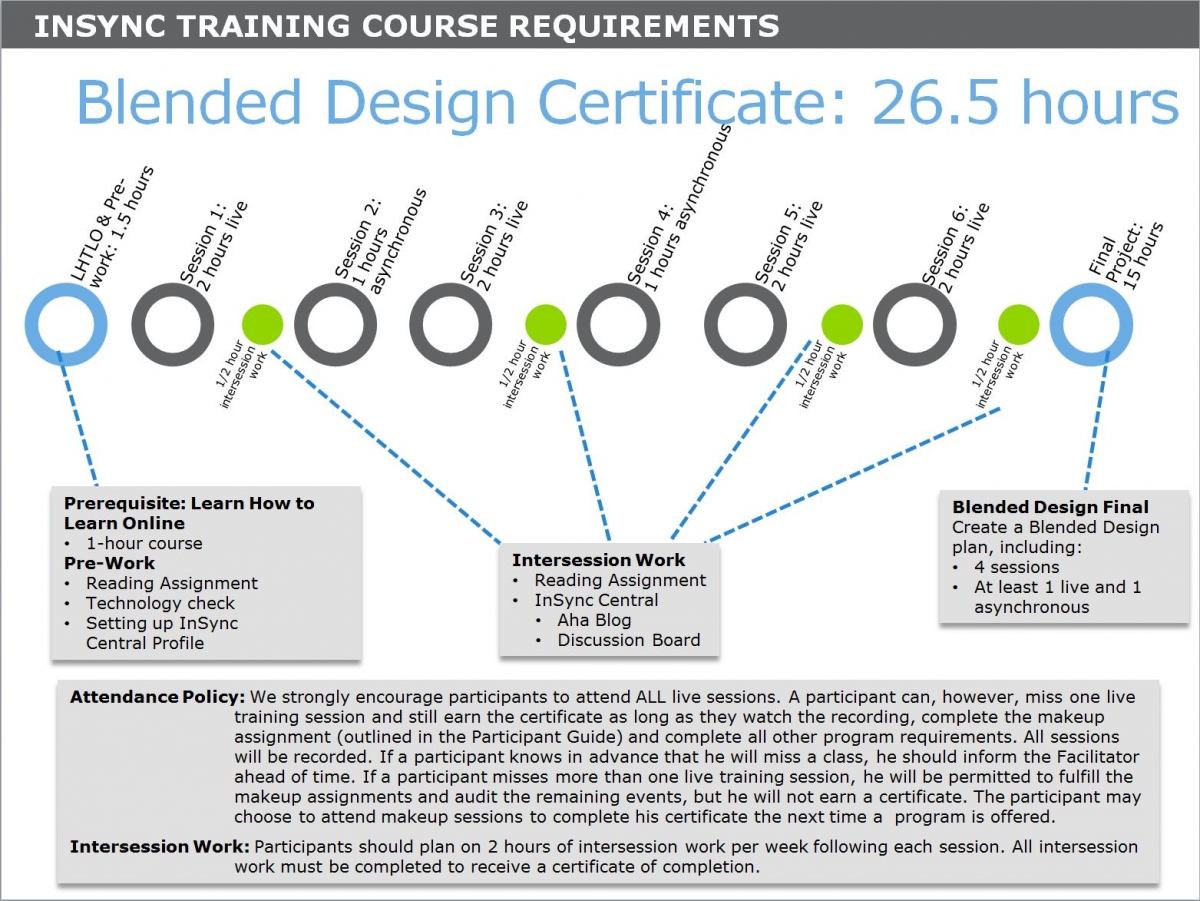
“Virtually There” is a monthly online column addressing the special challenges associated with designing, developing, and implementing virtual and blended learning.
Designing for the face-to-face delivery is hard enough; how do you transfer those skills to the virtual and blended delivery environments? Virtual learning is live learning delivered via a virtual classroom such as WebEx Training Center or Adobe Connect. Participants and facilitators interact and collaborate through speaking, whiteboards, breakout rooms, and other engagement types. Blended learning is a program in which performance objectives are matched to the most appropriate delivery medium or technology, including virtual training, self-paced training, and traditional classroom instruction. Program design determines the delivery method, and not the other way around.
It’s daunting because instructional designers don’t have as much experience as participants in virtual deliveries. Couple that with the fact that when a design falls apart, the participants usually know about it before the facilitator, so spending time on a tight design is critical up front. And designing in the WRONG way can be expensive when it comes to programming and technology adoption costs.
Don’t panic yet. As long as you spend the time on design up front, and don’t rely on technology to do the work for you, you can set the virtual stage for success.
This month’s column introduces five best practices for designing for virtual and blended environments by providing guidance on how to apply traditional design principles to the new delivery landscape.
1. Conduct an environmental analysis to fully understand the technology landscape. Did you know that your company’s offices in California decided not to install computer cameras in order to save $25 per machine? Or that bandwidth in your Africa offices is not able to support live video streaming? Does your salesforce work primarily on mobile devices?
Don’t make the mistake of assuming your participants’ learning environment look just like yours. People can work in cubicles, factories, private offices, or from their homes. Where will your audience be? Before committing to any delivery technologies, create a profile of target participants, including technology available, languages spoken, access to technical support, and learning environment.
2. Determine the desired learning outcomes and how mastery of these outcomes will be assessed. Get back to basics and apply true instructional design. What are you teaching and why? How will you know participants have met the desired level of mastery? Forgetting the tools for the time being, identify your instructional goal (what’s in it for your organization) and your performance objectives (what participants will be able to do differently; what they will know that they didn’t know before). TIP: Now is a good time to get feedback from your project sponsors that you are headed in the right direction.
3. Create an assessment plan for the individual learning components and for the entire blended program. Here’s the key step in the planning process: How can you assess that the learning objectives are being met? The reason this is so important is that the assessment techniques determine potential delivery technologies.
There is generally a direct correlation between the type of assessment you will use and the type of technology you will use to deliver the content associated with that assessment.
Remember, blended learning is not only about matching content to the most appropriate delivery medium, but doing it at the learning objective level. It’s the assessment technique that marries these two concepts.
Assessment doesn’t have to mean TEST (though it could). Breakout activities or flip-chart discussions often are used as assessments in traditional training programs. The purpose of these assessments is to ensure that content is being synthesized by the participant, and the facilitator can recognize that new content can be introduced, or if participants are able to apply what they have learned in a real-work setting.
So for each performance objective (and enabling objectives, if you have identified them), brainstorm multiple options for assessment. Don’t create the actual activities or tests, but document what you could use and why it would be appropriate. Multiple options for assessment will leave you with multiple options for delivery later on.
4. Map the learning outcomes to the most appropriate delivery methodologies. Now that you have identified what you are teaching through the learning objectives, and how you might assess mastery, it’s time to decide what technology fits best for each objective.
Technology selection should be the last step of the design process. Don’t try to determine if you can deliver your employee orientation content online (for instance, in a virtual classroom format), look at each learning objective of the program individually.
If you can assess the objective in a self-paced format, you probably can deliver the content in a self-paced format. If you need to assess in a live setting, then the content for that objective needs to be delivered in a virtual classroom, or perhaps even a traditional classroom. This process is what determines what your blend will look like, and what technologies should be included.
5. Create a validated instructional design plan to manage the development of the blend. You are still in the design stage of creating your program, and each step of the design stage should be validated and approved before moving on. Two tips for success:
Don’t start with the negative. Often, conversations around blended learning design center around “Well, we tried this before, and it won’t work here.” Create the best design possible, and then see if these observations are true constraints or old perceptions.
Don’t design in a vacuum, and include someone not familiar with the content so they are not sidetracked by what has been done before. The design process does not need to take a long time, but multiple perspectives and inputs almost certainly will result in a more thoughtful design.
Before moving to develop, create a document that contains your approved instructional goal, performance objectives, assessment techniques, and proposed technologies (i.e., your proposed BLEND), and submit it for approval to project sponsors. Include the technical profile of the learner. Think ahead to any questions (Why did you select this technology and not that? Will this work for everyone?) and incorporate those answers into your document.
A draft “course map” can help decision-makers understand your vision.

Going through this process potentially can save headaches, time, and money, down the road. It’s very expensive to design a great program that isn’t the RIGHT program.
Once your design document is approved, you are ready to move on to project planning and development.
What do these five best practices have in common? They are all focused on DESIGN and not TECHNOLOGY. Spending a day or two planning on paper, away from authoring tools and virtual classroom environments, will go a long way toward making sure your development initiative is on track.
Next month, we’ll discuss how to best develop this design so you maximize engagement and ensure your learning goals are met.
A thought leader in the field of virtual classrooms, Jennifer Hofmann is the president of InSync Training, LLC, a consulting firm that specializes in the design and delivery of virtual and blended learning. Featured in Forbes Most Powerful Women issue (June 16, 2014) as a New England Women Business Leader, she has led InSync Training to the Inc. 5000 as the 10th Fastest Growing Education Company in the U.S. (2013). Hofmann is the author of The Synchronous Trainer’s Survival Guide: Facilitating Successful Live and Online Courses, Meetings and Events (Pfeiffer, 2003), Live and Online! Tips, Techniques, and Ready-To-Use Activities for the Virtual Classroom (Pfeiffer, 2004), and How To Design For The Live Online Classroom: Creating Great Interactive and Collaborative Training Using Web Conferencing (Brandon Hall, 2005). She has co-authored, with Dr. Nanette Miner, Tailored Learning: Designing the Blend That Fits (ASTD, 2009), a book focused on taking advantage of distributed technologies to create the best blended training solution possible. Her most current projects include a monthly Training magazine online series titled “Virtually There” and her newest book, Body Language in the Bandwidth – How Facilitators, Producers, Designers, and Learners Connect, Collaborate & Succeed in the Virtual Classroom (InSync Training, 2015). Follow Jennifer Hofmann at her blog, Body Language In The Bandwidth at http://blog.insynctraining.com or on Twitter @InSyncJennifer.




